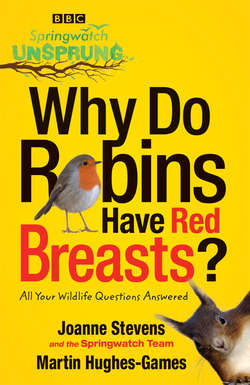Читать книгу Springwatch Unsprung: Why Do Robins Have Red Breasts? - Jo Stevens - Страница 9
Angry Birds
ОглавлениеWhy do blue tits fly up to windows and try to ‘attack’ their reflections? Cal
During the breeding season, birds are fired up by hormones and males can become particularly feisty, especially if they are trying to defend a territory. If the resident male catches sight of his reflection in a window, car wing mirror or other shiny surface he will try to see off the apparent ‘intruder’. It is most common to see this behaviour in spring, but birds that hold territories throughout the year, such as robins and grey wagtails, may be up for a fight at almost any time. A robin wouldn’t hang around attacking a mirror for long, though, as it defends its patch by finding a higher perch than its rival and would soon lose its reflection. An angry bird can be very persistent, keeping up the aggression for hours or sometimes days – this intruder just won’t leave! Usually the bird won’t hurt itself but it is a huge waste of their time and energy. If you’re concerned (or irritated!) you can help to remove the reflection by covering the window or mirror with paper or fabric.
You may be wondering why the bird doesn’t recognise its own reflection like we would. Natural reflections are rare and would soon disappear if attacked, for example in a puddle or pond. Very few animal species have been shown to recognise their own reflection, but biologists are very interested in this ability because it can give an insight into how animals’ minds work. To find out if an animal can recognise itself in a mirror, biologists put a coloured mark somewhere on its body while it’s unconscious or asleep in a place that it would only be able to see in a mirror, for example under its chin or on the end of its nose. If the animal pays attention to the mark in its reflection and touches its skin then this suggests that the animal understands that the reflection is itself. The ability to recognise oneself in a mirror suggests some kind of self-awareness.
A human baby doesn’t work out that the infant it can see in the mirror is actually itself until it reaches about 18 months old. This is about the same time that children develop what’s called a ‘theory of mind’; that is, they can infer what other people are thinking or feeling and begin to be able to put themselves in someone else’s shoes. Whether animals can do the same is a matter of huge debate among biologists who study animal behaviour. So far the only other animals shown to recognise their own reflections are similarly large-brained mammals such as chimpanzees, orangutans, elephants and bottlenose dolphins. However, there is one bird that has passed the mirror test: the magpie. Members of the crow family have been shown to be very intelligent, but does this mean that they are self-aware too …? It’s certainly food for thought.
